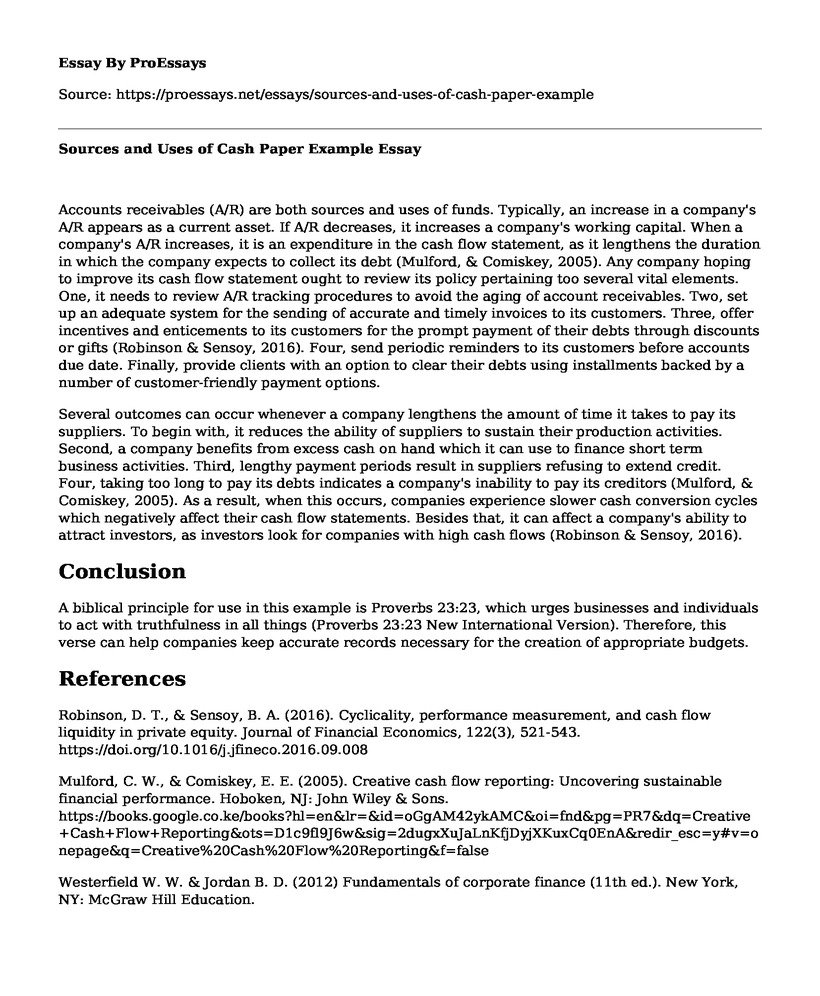Accounts receivables (A/R) are both sources and uses of funds. Typically, an increase in a company's A/R appears as a current asset. If A/R decreases, it increases a company's working capital. When a company's A/R increases, it is an expenditure in the cash flow statement, as it lengthens the duration in which the company expects to collect its debt (Mulford, & Comiskey, 2005). Any company hoping to improve its cash flow statement ought to review its policy pertaining too several vital elements. One, it needs to review A/R tracking procedures to avoid the aging of account receivables. Two, set up an adequate system for the sending of accurate and timely invoices to its customers. Three, offer incentives and enticements to its customers for the prompt payment of their debts through discounts or gifts (Robinson & Sensoy, 2016). Four, send periodic reminders to its customers before accounts due date. Finally, provide clients with an option to clear their debts using installments backed by a number of customer-friendly payment options.
Several outcomes can occur whenever a company lengthens the amount of time it takes to pay its suppliers. To begin with, it reduces the ability of suppliers to sustain their production activities. Second, a company benefits from excess cash on hand which it can use to finance short term business activities. Third, lengthy payment periods result in suppliers refusing to extend credit. Four, taking too long to pay its debts indicates a company's inability to pay its creditors (Mulford, & Comiskey, 2005). As a result, when this occurs, companies experience slower cash conversion cycles which negatively affect their cash flow statements. Besides that, it can affect a company's ability to attract investors, as investors look for companies with high cash flows (Robinson & Sensoy, 2016).
Conclusion
A biblical principle for use in this example is Proverbs 23:23, which urges businesses and individuals to act with truthfulness in all things (Proverbs 23:23 New International Version). Therefore, this verse can help companies keep accurate records necessary for the creation of appropriate budgets.
References
Robinson, D. T., & Sensoy, B. A. (2016). Cyclicality, performance measurement, and cash flow liquidity in private equity. Journal of Financial Economics, 122(3), 521-543. https://doi.org/10.1016/j.jfineco.2016.09.008
Mulford, C. W., & Comiskey, E. E. (2005). Creative cash flow reporting: Uncovering sustainable financial performance. Hoboken, NJ: John Wiley & Sons. https://books.google.co.ke/books?hl=en&lr=&id=oGgAM42ykAMC&oi=fnd&pg=PR7&dq=Creative+Cash+Flow+Reporting&ots=D1c9fl9J6w&sig=2dugxXuJaLnKfjDyjXKuxCq0EnA&redir_esc=y#v=onepage&q=Creative%20Cash%20Flow%20Reporting&f=false
Westerfield W. W. & Jordan B. D. (2012) Fundamentals of corporate finance (11th ed.). New York, NY: McGraw Hill Education.
Cite this page
Sources and Uses of Cash Paper Example. (2022, Nov 28). Retrieved from https://proessays.net/essays/sources-and-uses-of-cash-paper-example
If you are the original author of this essay and no longer wish to have it published on the ProEssays website, please click below to request its removal:
- Phenomena of Facebook and Twitter as Globalization Force Essay
- Essay Sample on Corporate Policies
- Research Paper on Exploring Investment Options for HNW Clients: Strategies & Benefits
- Wealth Tax: Progressivity in Action in 4 European Countries - Essay Sample
- Employee of the Month: A Moment of Pride and Appreciation - Essay Sample
- Senegal: Africa's Economic Giant With 6% GDP Growth - Research Paper
- The Politics of Performance Appraisal: Human Resource Management







